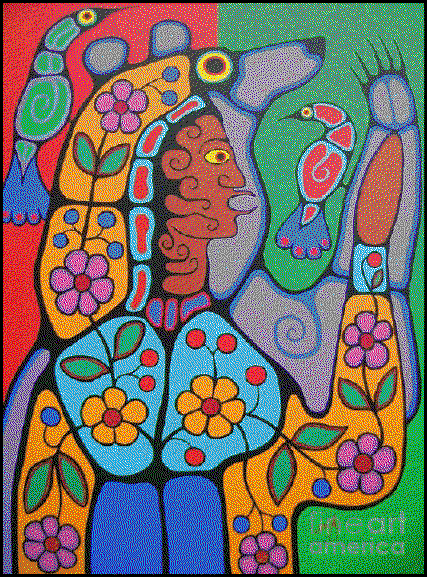An Indian's Journey
Through Reservation Life
David Treuer
(Atlantic Monthly Press)

Further, "Some Indians don't have reservations, but all reservations have Indians, and all reservations have signs." These reservations encompass slightly over 2% of the land in the United states, and there are now 2,000,000 Indians --- up from 250,000 in 1900.
Treuer offers us a slice of Indian life in America: not only the squalor of a people who lost so much to the invaders from the east, but some more upbeat items, fond memories of his own, from his own childhood and from his parents, brothers, sisters and cousins. There is his annual return from Los Angeles to Leech Lake Reservation in Minnesota. His family is of the Objibwe --- known as non-confronting, even pacifist, unwilling to create problems.
The early pages of Rez Life tells of a quick trip to Bena to bury his grandfather (suicide). Treuer's grandmother asked him to do just two things in his time there: write a eulogy, for he's the family writer, a novelist, historian. And, she said, Clean it up, referring to her husband's shack. This last task creates a sad set piece, another eulogy ... a eulogy for a carpet, the carpet that his grandfather had died on, one that was old and worn and dusty and bloody.
- I cursed that carpet as I'd never cursed anyone in my life. On I went. I hated that cheap, thin, blue, foam-backed, glue-down carpet more than I have ever hated anyone or anything. That carpet, that cheap, cheap carpet, that carpet the same color as the reservation is colored on some maps of northern Minnesota. And just as torn, dusty, and damaged. Just as durable. Just as inadequate.
"We all struggle to do our jobs --- the job of living, the job of dying, the job of muddling the two --- but that carpet didn't do its job. It didn't keep its end of the bargain."
It's a proper introduction to the dilemma of the modern American Indian, and takes us around the edges: the why and how of reservation life, the way of his grandfathers, the murder feast of Andrew Jackson and his Indian killers, the War of 1862 between the Dakotas and the whites, the timber grabs, the squalid lives (hovels, drunkenness, poverty), the kidnapping of children for the BIA schools, and always promises of land and resources; promises never delivered on.
But it would be a wretched volume that only told of woe. Treuer has other stories to tell, and reminds us that many of his brothers aren't angels: "A lot of African Americans with Indian blood had Cherokee blood --- and not because the Cherokee and African Americans were good friends, but because Cherokee masters slept with their black slaves."
And all government acts did not end up robbing and stealing Indian assets. The Indian Reorganization Act of 1934 under Roosevelt's New Deal moved in the direction of giving Indians governing rights on their own lands. It gave the first commissioner John Collier the hope that "Our task is to help Indians meet the myriad of complex, interrelated, mutually dependent situations which develop among them according to the very best light we can get on those happenings --- much as we deal with our own perplexities and opportunities."
And, lest we forget, it was the Supreme Court of the United States who, in 1976, made it possible for Indians to enjoy a windfall on their own reservations: legalized gambling. This is now no small deal: "Indian gaming brought in $25 billion dollars in 2006, compared with the $12 billion generated in Las Vegas." Some of this money is trickling down to at least some of the Indians who have lived in poverty for decades.
Turns out that Treuer knows the Indians that created this sea-change in the fortunes of the reservations. And the reason it came to pass: by 1976, "the federal government was getting out of the Indian business. This was not because it wanted Indians dead --- by that time, it just didn't care." The case was a part of that old battle between the feds and the states: whether the states should have rights to tax those who lived on "federal" property ... eg, the reservations.
Bryan v. Itasca County, was carried almost by chance to the high court (most of the pro bono lawyers had dropped out by this time). The key question was who had the jurisdiction in matters of civil law on Indian land. And forty years ago, no one saw that a simple decision could open up such a gold mine.
"People thought immediately about taxes on income and property. Some thought about courts and civil cases," writes Treuer. "But almost no one thought about gambling until the Cabazon Band and the Seminole started up their card rooms four years later. In subsequent Supreme Court decisions, the rights of the tribes to establish their card rooms was upheld, and
- The federal government, seeing the influx of casino money to reservations, has been happy with the arrangement: it has to pay less for and worry less about that pesky "Indian problem."
Treuer ends on a sweet note. His visits to Leech Lake are tranquil adventures in the Minnesota woods, trapping, hunting, netting walleye, tapping sugar bush in the snow. Still, and as always, even in the peaceful wilderness, the old bitterness can creep in:
- The worst thing that happened to us was that we became Americans. They trained us to become the worst kind of Americans and then blamed us for it. That's why language and culture are so important. By stressing those things we can stop being what they want us to be, bad Americans. But it took one hundred years to get to this point. It will take one hundred years to get back.